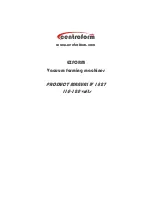
408-7183
3 of 5
Rev B
8.Remove the crimped terminal from the crimping jaws
and inspect the crimp. The crimp dot code on the color
coded sleeve will identify the hand tool used. Make
sure that the proper crimp dot code is shown for the
appropriate hand tool. Refer to Figure 1. Check the
insulation grip by referring to Section 4, INSULATION
CRIMP ADJUSTMENT.
4. INSULATION CRIMP ADJUSTMENT
Each hand tool has three insulation crimp adjustment
positions to adjust the wire insulation grip: 1--Tight,
2--Medium, and 3--Loose. To obtain the desired
insulation grip, proceed as follows:
1. Insert insulation crimping adjustment pins into
Position 3 as shown in Figure 1.
2. Insert the contact into the tool as shown in
Figure 3.
3. Insert an UNSTRIPPED wire into the insulation
barrel of the contact.
4. Hold the wire in place and squeeze the tool
handles to crimp the contact.
5. Open the tool handles and remove the crimped
contact. Check the insulation crimp by bending the
wire back an forth (one time only). If the wire pulls
out, set the pins in the next smaller position. Repeat
these procedures until the proper insulation crimp is
obtained. The crimp should be tight enough to hold
the insulation firmly without cutting into the
insulation.
NOTE
i
The pins must be located in the same adjustment
position.
5. MAINTENANCE AND INSPECTION PROCEDURE
It is recommended that a maintenance and inspection
program be performed periodically to ensure
dependable and uniform terminations. Frequency of
inspection depends on:
•
The care, amount of use, and handling of the hand
tool.
•
The presence of abnormal amounts of dust and
dirt in your facility.
•
The degree of operator skill.
•
Your own established standards.
The hand tool is inspected before being shipped from
the plant; however, it is recommended that the tool be
inspected immediately upon arrival to ensure that the
tool has not been damaged during shipment.
5.1. Daily Maintenance
1. Hand tool should be immersed (handles partially
closed) in a reliable commercial degreasing
compound to remove accumulated dirt, grease, and
foreign matter. When degreasing compound is not
available, tool may be wiped clean with a soft, lint-
free cloth. DO NOT use hard or abrasive objects
that could damage the tool.
2. Make certain that the retaining pins are in place
and that they are secured with retaining rings.
3. All pins, pivot points, and bearing surfaces should
be protected with a thin coat of any good SAE† 20
motor oil. Do not oil excessively.
4. When the tool is not in use, keep handles closed
to prevent objects from becoming lodged in the
crimping jaws. Store the tool in a clean, dry area.
5.2. Lubrication
Lubricate all pins, pivot points, and bearing surfaces
with SAE 20 motor oil as follows:
— Tools used in daily production-lubricate daily
— Tools used daily (occasional)-lubricate weekly
— Tools used weekly-lubricate monthly
Wipe excess oil from tool, particularly from crimping
area. Oil transferred from the crimping area onto
certain terminations may affect the electrical
characteristics of an application.
5.3. Visual Inspection
1. Close tool handles until ratchet releases and then
allow them to open freely. If they do not open
quickly and fully, the spring is defective and must be
replaced.
2. Inspect head assembly for worn, cracked, or
broken jaws. If damage is evident, return the tool to
TE for evaluation and repair. See Section 6,
REPLACEMENT AND REPAIR.
5.4. Gaging the Crimping Chamber
Crimp height inspection is performed through the use
of a micrometer with a modified anvil, commonly
referred to as a crimp height comparator.
TE does not market crimp height comparators. Refer
to Instruction Sheet 408-7424 for detailed information
on obtaining and using a crimp height comparator.
If the crimping chamber conforms to the gage
inspection, the crimping chamber is considered
dimensionally correct, and should be lubricated with a
THIN coat of any good SAE 20 motor oil. If not, the
tool must be returned to TE for further evaluation and
repair. Refer to Section 6, REPLACEMENT AND
REPAIR.
1. Remove traces of oil or dirt from the crimping
chamber and plug gages.
†SAE is Society of Automotive Engineers.























